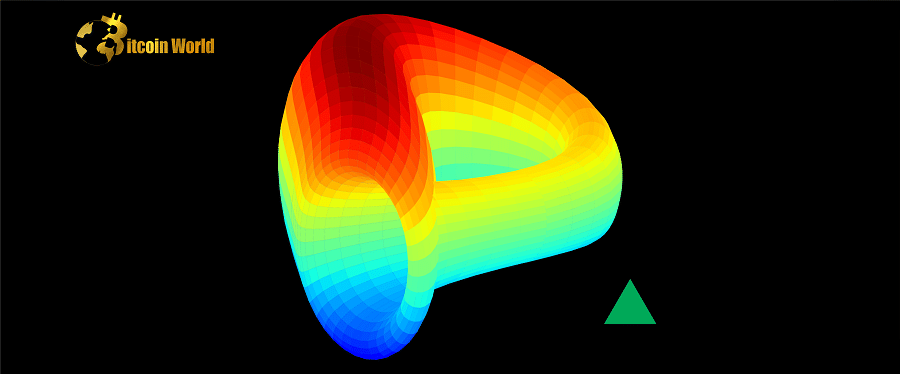In the ever-evolving world of cryptocurrency, shifts in sentiment and regulatory landscapes can trigger significant market movements. Recently, we’ve witnessed a notable surge in interest surrounding decentralized stablecoins, and tokens associated with protocols like Curve are reaping the rewards. What’s behind this shift, and what does it mean for the future of stablecoins? Let’s dive in.
Why is Curve (CRV) Token on the Rise?
Over the past 24 hours, Curve’s native token, CRV, has experienced an impressive 11% jump. This isn’t just another crypto pump; it’s a reaction to broader market dynamics, specifically growing concerns around centralized stablecoins, particularly Paxos’ BUSD. But how are these events connected?
The BUSD Factor: A Catalyst for Decentralization
Recent news has cast a shadow over centralized stablecoins. Reports surfaced that the U.S. Securities and Exchange Commission (SEC) is contending that BUSD, a stablecoin issued by Paxos, is an unregistered security. This revelation, coupled with earlier reports of an investigation into Paxos by the New York Department of Financial Services, has created unease among crypto traders.
Why does this matter for decentralized stablecoins and Curve? Traders are understandably wary. Regulatory scrutiny on centralized offerings like BUSD is prompting a flight to perceived safer havens – decentralized alternatives. Investors are seeking stablecoins that operate outside the traditional regulatory framework, hoping to avoid similar legal implications in the future. This is where decentralized stablecoins, and protocols like Curve that support them, come into the spotlight.
Curve and the Promise of crvUSD
While Curve currently doesn’t have its own native stablecoin, the crypto community is buzzing with anticipation for Curve‘s upcoming decentralized stablecoin, crvUSD. Rumors of this dollar-pegged asset have been circulating since June, and recent developments suggest the launch might be closer than ever.
Hints of crvUSD Launch?
Adding fuel to the fire, Curve recently hinted at the imminent arrival of crvUSD. A proposal is currently underway that is described as “needed for crvUSD to function autonomously.” This proposal focuses on enabling stablecoin pools to share crucial pricing data with external protocols. This move is widely interpreted as a critical step towards launching crvUSD.
For traders, this signal was a clear call to action. The anticipation of crvUSD has significantly boosted demand for CRV tokens, with trading volume exploding to over $770 million across various cryptocurrency exchanges. Investors are betting on Curve’s future in the decentralized stablecoin space.
What Makes Curve So Popular?
Curve isn’t just another DeFi platform; it’s a major player. Here’s why it commands such respect and attention:
- Decentralized Focus: Curve champions the core principles of DeFi by using smart contracts to provide financial services like borrowing, lending, and trading, eliminating the need for traditional intermediaries.
- Attractive Yields: Depositors on Curve can earn competitive annual percentage rates (APYs), sometimes reaching up to 4%, by participating in various liquidity pools.
- Massive Liquidity: Curve is one of the most prominent protocols in the crypto world, boasting a staggering $4.6 billion in total value locked (TVL). This indicates strong user confidence and deep liquidity.
- Focus on Stablecoins: Curve is particularly renowned for its efficient stablecoin swaps, making it a go-to platform for trading between different stablecoins with minimal slippage.
Decentralized vs. Centralized Stablecoins: What’s the Difference?
The current market dynamics highlight the fundamental differences between decentralized and centralized stablecoins. Let’s break it down:
| Feature | Centralized Stablecoins (e.g., BUSD, USDT, USDC) | Decentralized Stablecoins (e.g., DAI, crvUSD – upcoming) |
|---|---|---|
| Backing | Typically backed by fiat currency reserves (like USD) held in traditional financial institutions. | Backed by a basket of cryptocurrencies, often overcollateralized or algorithmically managed. |
| Regulation | Subject to regulations and oversight from traditional financial authorities. | Aims to operate outside of traditional regulatory frameworks, relying on code and community governance. |
| Transparency | Transparency varies; reserve audits are sometimes conducted but may not be fully transparent or real-time. | Transactions and backing are typically transparent and verifiable on the blockchain. |
| Censorship Resistance | Potentially subject to censorship or freezing of funds by centralized issuers or regulatory bodies. | Designed to be censorship-resistant and permissionless. |
The recent SEC scrutiny on BUSD underscores the regulatory risks associated with centralized stablecoins. This is a key factor driving the current interest in decentralized alternatives like crvUSD.
Expert Perspective on crvUSD’s Potential
Daniel Zlotin, a senior DeFi developer at Orbs, shared his insights with CoinDesk, stating that “the crvUSD might be a really intriguing development, given we haven’t yet seen a stablecoin issued by a large DEX [decentralized exchange].” He highlights the potential of combining a stablecoin with a robust DeFi platform like Curve, suggesting innovative models such as using LP tokens as part of the backing system. However, he also acknowledges the challenges inherent in implementing such a novel concept.
Looking Ahead: The Future of Stablecoins?
The current surge in CRV token price and the growing anticipation for crvUSD signal a significant shift in the stablecoin landscape. As regulatory pressures mount on centralized stablecoins, decentralized alternatives are gaining momentum. Curve, with its established DeFi platform and the upcoming crvUSD, is positioning itself at the forefront of this evolving market.
Will crvUSD live up to the hype? Will decentralized stablecoins become the dominant force in the crypto space? Only time will tell. However, one thing is clear: the demand for decentralized financial solutions is growing, and Curve is ready to meet that demand head-on.
Disclaimer: The information provided is not trading advice, Bitcoinworld.co.in holds no liability for any investments made based on the information provided on this page. We strongly recommend independent research and/or consultation with a qualified professional before making any investment decisions.


